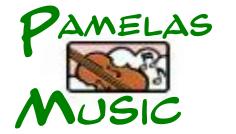|
A dictionary of banjos
|
| Banjo geige |
A German invention of
the 19th century combining the scroll, neck and strings of the
violin with a banjo head. |
| Banjo harp |
A 19th century
American zither made in the form of a harp with 18 strings. |
| Banjolin |
The four-string
counterpart of the Banjo-mandolin; i.e. having the same tuning as
the mandolin but in single courses instead of pairs. It was
devised to enable mandolinists in the BM & G orchestras to
replace the banjorine (qv) in the lead, thereby simulating, to some
extent, the required banjo tone. To this end, the banjolin hoop was made to the same size as that
of the banjo, 10 ½ inches or 11 inches in diameter, which gave
extra volume. Normally played open-backed but occasionally
fitted with a wooden or metal resonator. It is still used in
BM & G orchestras and in some quartets and quintets. |
| mandolin banjo |
An eight-string
hybrid, having a mandolin neck attached to a zither-banjo type
(closed hoop) of from 5.9 inch diameter. Played mandolin
fashion, like the banjolin, it provided a "doubling"
instrument for orchestral players who were already familiar with
"fifths" tunings. Less incisive than the bajo, it is
also more likely to produce unwanted overtones. Open back and
resonator types also made. |
| Banjo mandolin |
Confusingly. August
Pollman. USA had a a 5string banjo produced with a mandolin body circa
1895 (Pamela's collection) There are earlier examples of this style
of instrument by other makers. A modern version now on the market called
a banjola. |
| Banjolele |
See "Banjulele" |
| Banjorine |
A small five-string
banjo, tuned a fourth higher than the normal type. Introduced
by the American banjo maker SS Stewart for use as a lead instrument
in BM & G orchestras, and called by him "the banjeaurine",
it was eventually displaced by the banjolin and is now obsolete. |
| Banjo zither |
A type of zither (not
to be confused with the zither-banjo) invented by CL Steffen, of
Stettin, in 1879; it had a banjo type body with "f" sound
holes and a long neck. |
| Banju |
A banjo-type
instrument, with four strings, believed to have been brought into
Cuba from North America. |
| Banjuke |
See "Banjulele". |
| Banjulele |
The registered trade
name coined by the Keech brothers for their adaptation of the
ukulele neck to a banjo-style hoop, in order to produce a greater
carrying power than that of the quiet-voiced ukulele. It
enjoyed a boom period in the 1920s and was popularised by Kel and
Alvin Keech, Roy Smeck, Arthur Godfrey, George Formby, Billy Scott,
Tessie O'Shea and other professionals. Other
makers quickly produced their own versions of the instrument, for
which various names were coined, notably "Banjuke"
(Clifford Essex) and "Gemuke" (Windsor), but to the
majority it was the ukulele-banjo or banjolele.
Originally gut-strung, it is normally strung with nylon, almost
invariably has a resonator and is now enjoying a revival. The
George Formby Appreciation Society, and the Ukulele Society have
increasing membership numbers, with the accent seemingly on
banjolele rather than ukulele. Great interest is being shown
in pre-war models such as those of Ludwig and Abbott. |
| Banshaw |
An 18th century name
for the African gourd banjo. |
| Banza |
A guitar-like
instrument found in Haiti, having four strings, a skin soundboard
and a half-gourd body. First recorded in Martinique in 1678 |
| Banzie |
A Congolese
stick-zither. |
| Banzu |
A Congolese board
zither, unusual in that it has a resonator. |
| Bapili |
A Congolese board
zither. |
| Barbat |
A Persian member of
the lute family, its name being possibly an Arabic corruption of
Barbiton. From about AD 600 until the 11th century it was
unfretted. It is probably of Byzantine origin. |
| Bass banjo |
A banjo with cello
tuning (CGDA) often - and rightly - called the cello banjo.
Designed for use in the BM & G orchestra, it also provides an
ideal bass voice in quartets/quintets. It has a 15 inch hoop,
sound board of vellum, and is played with a
plectrum. The bass banjo was used with conspicuous
success by the Emile Grimshaw Quartet in the 1920s ans in the filmed
and recorded performances of Raymonde's Band of Banjos when it was
played by Bert Bassett. There are also contra bass banjos usually
three strings double bass size. A 5 string zither bass banjo is also
in evidence (Pamela's collection !) |
|
|
| Frailing
banjo |
A playing style
with an open back 5 string. Frailers often have fewer frets as
picking is done over the lower fingerboard. Also clawhammer banjo, a
style of playing. |
| Fretless
banjo |
Banjos were first
commercialised in the 1840s, had no frets... although appearing with
frets on some examples from 1860s often continued fretless to 1890s. Later examples had satinwood or boxwood fret
markers inlaid. Fretless banjos of the 1850-80s typically had 6-7
strings, gradually standardised to 5 string examples. There are
examples of early banjos with many more strings. Some
decorated with Tunbridge ware
inlays others with mother of pearl. |
| . |
The fifth short
drone string or chanterelle distinguishing the banjo is said to have
appeared in the 1700s. Most instruments had three strings at that
time the drone making the fourth. 1769 white players were performing
with blacked faces. By 1830s solo blackfaced performers were a
popular entertainment. |
| Piccolo
banjo |
A small version of a 5
string (See banjourine). Some early examples of 6 & 7 string also. (Pamela's
collection) |
| Seeger
banjo |
A 5 string folk banjo with a
longer neck. 2 extra frets before the 5th string peg. Popularised by
Pete Seeger in 1950s. |
| Minstrel
banjo |
An early
usually backless, fretless wooden 5, 6 or 7 string banjo |
| Tack
head. |
A very early banjo
without tensioners. Vellum was tacked onto the wooden pot. 1850s and
before. |
| Zither
banjo |
The zither banjo
became popular towards the end of the 19th century. Usually 5 string
(often with 6 tuners). Typically featuring an a wooden
resonator encompassing a cast metal pot, and no perch pole. The 5th
string usually was diverted through a metal tube under the fret
board from the 5th fret to the tuning head. Considered a superior
design of banjo at the time. Examples of 6 string , 7 string, tenor and mandolin
banjo also made. |



